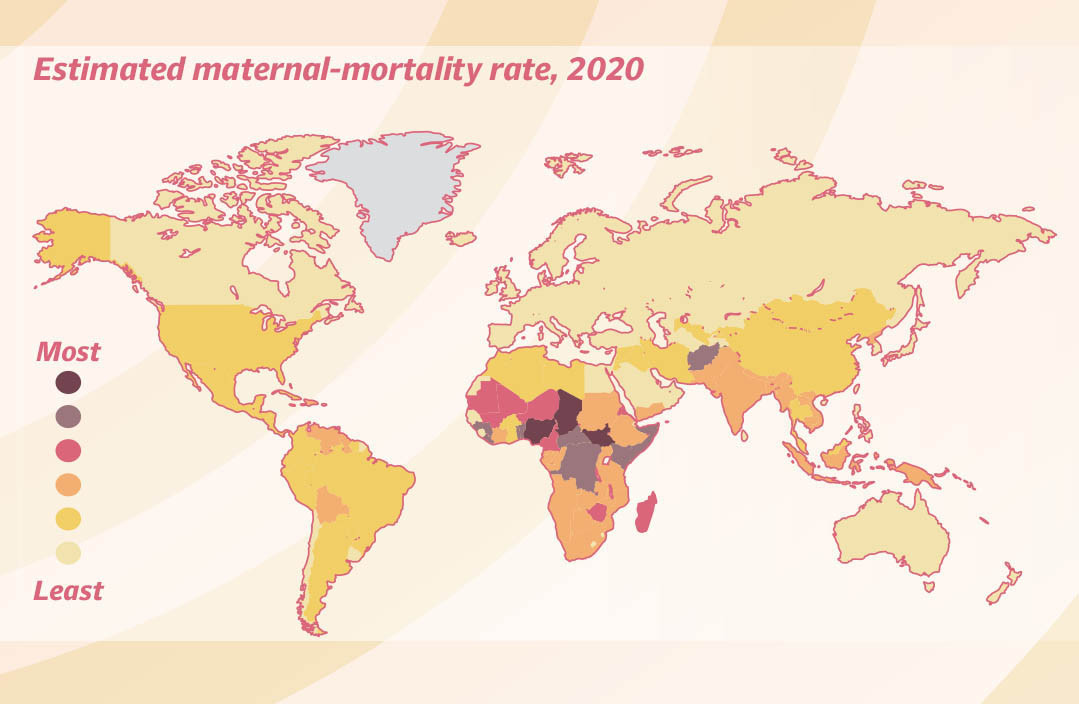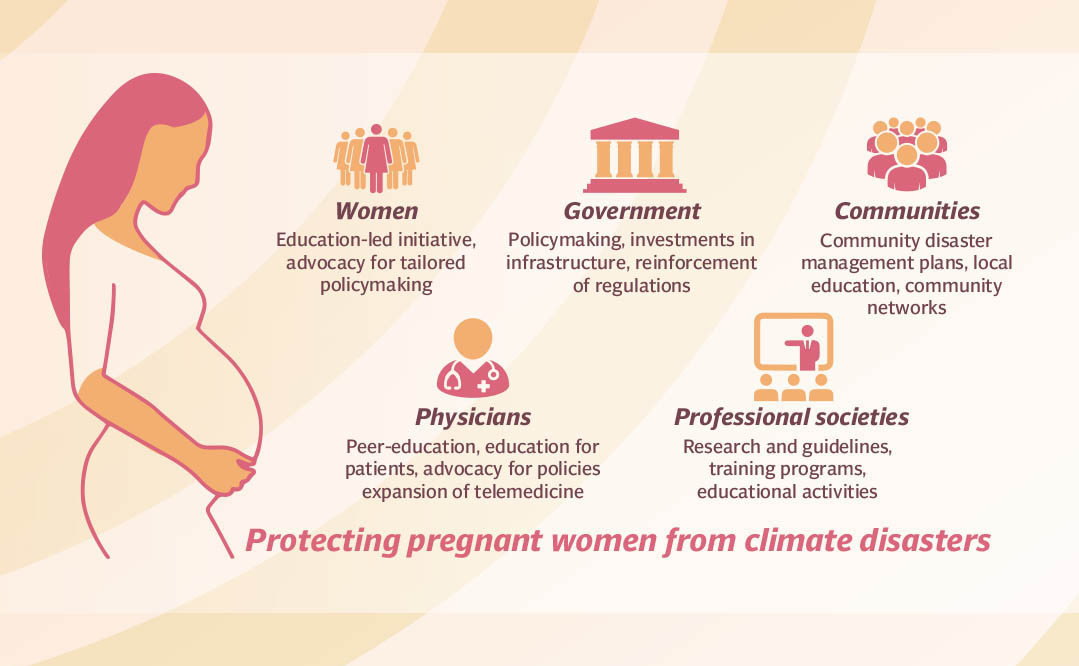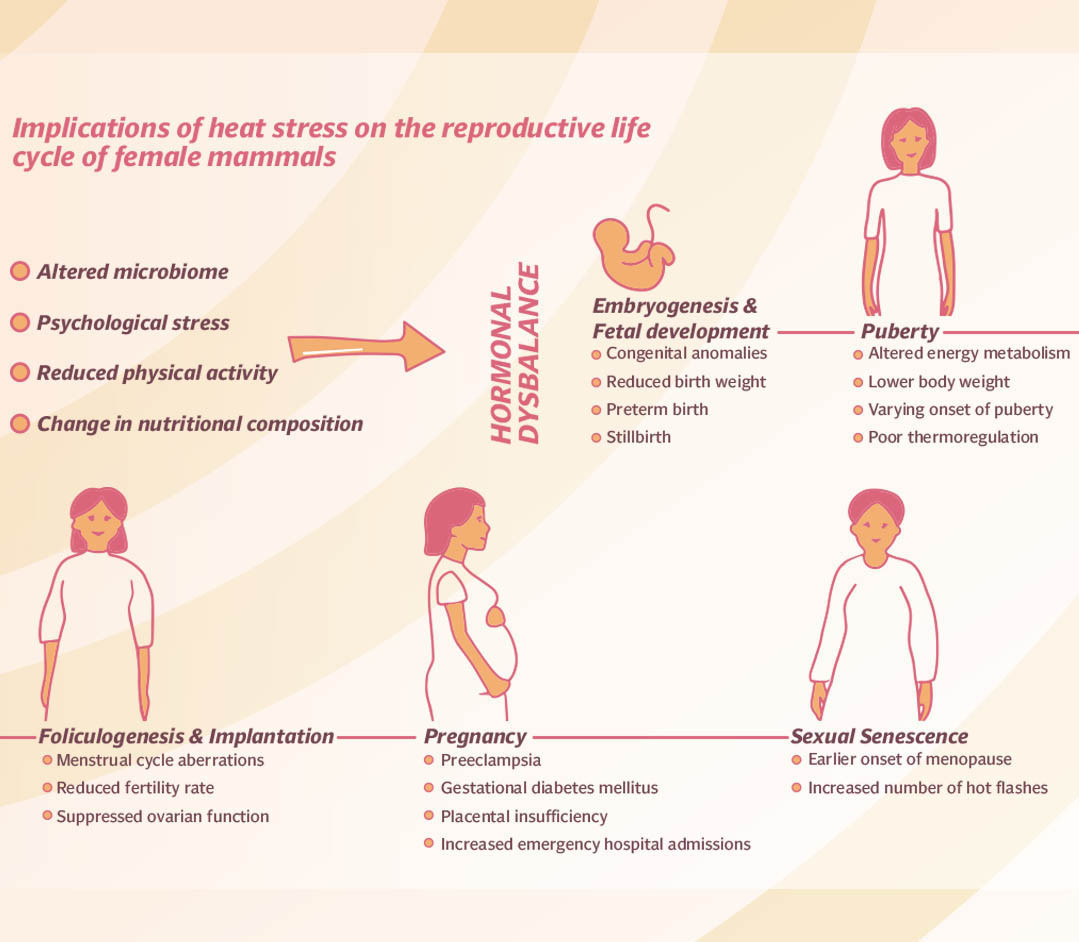Pregnancy and childbirth in Pakistan often receive insufficient attention and care in general, but this is especially true for the country’s rural areas. Women continue to work in fields under harsh conditions, even until the final weeks of their pregnancy. These circumstances not only make childbirth difficult but also hinder the ability to maintain a healthy motherhood.
Add to this the challenge posed by extreme heat and climate change. As average air temperatures rise, extremely hot spells become more frequent. Climate models indicate that the frequency and duration of intense heat episodes are projected to increase in most representative concentration pathway scenarios. These heightened heat events are expected to have a greater impact on health. Children born in 2020 are predicted to face a two- to seven-fold higher risk of extreme weather events compared to those born in 1960, emphasising the increased danger of heat waves among other events.
According to UNICEF estimates, currently, 559 million children worldwide are exposed to high heatwave frequency. By 2050, nearly two billion children will inhabit the Earth, and it is predicted that heatwaves will occur more frequently.
Heatwaves are a challenge worldwide, but the South Asian subcontinent is especially vulnerable. According to data from the World Weather Attribution Initiative, the region experienced 11 previously unprecedented heatwaves during the summer of 2022, undoubtedly exacerbated by global warming induced by climate change. There was a risk that over a billion people in India and Pakistan would be exposed to temperatures exceeding 40°C, with Jacobabad, Pakistan, reaching as high as 50°C (120°F).

Motherhood in harsh conditions
Nazneen Ali, 34-year-old who lives in a small village near Ranipur, Sindh, saw her mother breathe her last while giving birth to her brother. Since then, she resolved to avoid situations that could negatively affect her own children. "In our village, women wake up, clean their houses, prepare breakfast, serve everyone, and then head to the fields for work," she explained, detailing her daily routine. After work, she manages household chores, cooks dinner, and tends to her two children, aged five and three years.
Nazneen opted against the healthcare facilities in the village and chose not to give birth there. "My sister lives in Hyderabad, and from day one, I made it clear to my husband that I would go there to deliver my children because the harsh environment in our village makes it more difficult," she explained. She mentioned that temperatures can rise up to 48°C in their village.
Pregnant women across the country are suffering from heat-related illnesses, such as fainting and hospitalisation due to dehydration. Like many others, Nazneen was worried that her fetus was moving less because of the intense heat. However, she was still compelled to work, which only increased her body's heat further. Many women from her village are also concerned that intense heat during pregnancy or nursing reduced their appetites, believing it had a detrimental effect on their nutrition. The lack of clean water for breastfeeding children has compounded the issue, making nursing even more challenging.
"The issue wasn't just about giving birth in better conditions, but the postpartum period is also a struggle for us women in extreme heat, aside from the nine months of pregnancy where we constantly worry about the consequences of changing weather," Nazneen explained, recalling her second pregnancy during the scorching summers when temperatures became unbearable. She mentioned how heatwaves affected eating and sleeping patterns, making it feel like she couldn't breathe while working, especially since she was already nursing a one-year-old boy during her second pregnancy. To make ends meet, Nazneen and other mothers in her village endured exhaustion and desperation, spending hours manually fanning themselves and their newborns in the absence of electricity.
Nazneen is not alone in choosing this option; many women with relatives living outside the village do the same due to the lack of facilities, increasing temperatures, and inadequate clean drinking water. "We can't keep enduring stillbirths and low-weight births while suffering," she explained. "So, we considered alternatives. But not everyone can do this because it requires money, time, and a place to stay, which unfortunately not everyone has." She mentioned that she started saving money as soon as she got pregnant so they would have enough for the journey to the city.
While the catastrophic risks of climate-related heatwaves, like the one that struck Sindh in 2022, receive more attention, pregnant women are particularly vulnerable to harm from these events. Heatwaves have been linked to increased rates of stillbirth, preterm delivery, and maternal hypertension. Overall, high temperatures have adverse effects on various aspects of sexual and reproductive health, including the psychological effects of pregnancy, and they also contribute to feminised poverty.

The challenge of data
Rising temperature and climate change are profoundly affecting the country, particularly rural areas. People there are experiencing direct impacts on health and agriculture. Pregnant and newly delivered mothers in Sindh Province urgently require accessible cooling options like fans, trees, and clean water, along with financial support, especially in the face of deadly heatwaves. "The severity of the issue and its outcomes are evident. We're witnessing issues such as low birth weight, preterm births, low-weight births, and even stillbirths. Additionally, many congenital diseases are prevalent among children born in areas that have experienced extreme climate conditions in recent years," explained Dr Jai Das, Assistant Director at the Institute for Global Health and Development, Aga Khan University Hospital.
Low-income regions worldwide, including Sindh, are experiencing alarming increases in both daytime and nighttime temperatures due to climate change. However, little is being done to establish safeguards, and climate resilience planning often overlooks the needs of expectant mothers and newborns, even in Pakistan. Additionally, the country lacks comprehensive data on how heat affects pregnant women because there has been limited research conducted in specific areas. "Retrospective data is scattered, and we have weak information on this topic due to the lack of extensive research, which hinders our ability to make correlations and establish a clear direction," explained Dr Das. He further mentioned that the Aga Khan University Hospital is conducting a four-year-long research project to investigate how heat impacts pregnancies and identify relevant factors.
Limited access to cooling presents significant risks for gendered care labor, such as cooking over open flames, fetching water, caring for children, and performing unpaid farm work for the family. Additionally, patriarchal norms restrict women's access to cool spaces, such as stores or shaded areas, while men have unrestricted access. "Research from various parts of the world suggests that at least 15 per cent of women are affected by rising temperatures," shared Dr Das. He also mentioned that the research conducted by AKUH includes 6,000 women from three districts of Sindh: Matiari, Tando Muhammad Khan, and Tharparkar. "Women from these districts will be registering with us over the next two years, and we will observe them throughout their pregnancies, considering various factors to understand the underlying causes of birth issues in Sindh," explained the assistant director. These districts were selected based on factors such as proximity to health centers and variations in temperatures.

The research project aims to understand the main causes by implementing two approaches. Firstly, devices such as I-buttons will be provided to women, which can be attached to the chest to detect vitals and record data for research purposes. "These devices will be capable of recording blood pressure, heart rate, temperatures, and other factors," explained Dr Das. Additionally, follow-up care will be provided to these women in our centers, including blood tests, echocardiograms, and ultrasounds for both the women and the fetus, to monitor the impacts of various factors. "The research will explore different aspects, with a focus on intensity, frequency, and duration," he added. "For instance, we will analyse how long each woman was exposed to direct or indirect heat during which week of her pregnancy, and whether the heat was continuous or occurred at different times of the week. All such details will be carefully considered."
Heat stress during pregnancy can have several detrimental impacts on both the developing fetus and the pregnant mother. Studies have shown that higher temperatures are associated with lower birth weight and length, shorter gestational duration, and an increased risk of preterm birth. These risks vary depending on the location and are linked to heat exposure during specific pregnancy windows, suggesting the influence of other physiological and environmental factors.

Climate change impacts
Globally, heat waves are becoming more frequent, longer-lasting, and more intense due to climate change. In parts of South Asia, a combination of climate conditions, topography, dense population, and occupational exposures make certain areas especially vulnerable to excessive heat stress. "People are becoming increasingly aware of the serious issue, noting that the size and weight of their newborns are smaller than those born just a few years ago. The signs are clear and undeniable," explained Dr Das, emphasising the concerns of those directly affected who can observe the changes in their lives.
Hot weather poses risks beyond heat-related illnesses; it also increases the likelihood of cardiovascular and respiratory disorders, mental health issues, adverse pregnancy outcomes, and strains on local healthcare systems, ultimately leading to increased mortality. Over the past two decades, south Asia has experienced severe heat waves resulting in human and livestock fatalities.
According to analysis from the World Weather Attribution project, climate change has heightened the probability of catastrophic heatwaves, such as the one that struck areas of India and Pakistan in 2022, by 30 times. With rising temperatures expected annually across the region, the dangers to pregnant women and newborns are projected to increase significantly, particularly given the prevalence of nutritional challenges among women of reproductive age.
In September 2022, Pakistan faced its worst flooding in recent memory, triggered by intense monsoon rainfall. The deluge submerged over one-third of the nation, displacing 33 million people—equivalent to 15% of Pakistan's total population—and resulting in over 1,500 fatalities. Women and children bore the brunt of the disaster. According to the United Nations Population Fund (UNFPA), damage to medical facilities put the lives of women and girls, especially expectant mothers, at risk and disrupted the provision of basic healthcare services. It was estimated that over 650,000 pregnant women had limited or no access to healthcare, with 73,000 of them nearing the end of their pregnancies. This is in contrast to the 2010 floods, which affected an estimated 150,000 pregnant women.
A study of over 500 expectant mothers affected by the 2010 deluge found significant obstetric complications: 13.8% had abruptio placentae, 12.1% had premature rupture of membranes, 27.5% experienced obstetrical trauma, 25.0% had postpartum hemorrhage, and 15.1% suffered from sepsis. These findings could inform the scale of potential obstetric impacts from the recent 2022 flood.
Health officials have also expressed concerns that maternal mortality rates may rise due to various factors such as the unregulated use of veterinary drugs, reliance on untrained delivery attendants, limited access to health facilities, and hospitals being overwhelmed or empty. Despite this, there is currently limited information available on the obstetric consequences of floods.
The reason women are particularly affected is straightforward: when body temperature rises, blood flow increases, directly impacting the fetus connected via the umbilical cord. "This has adverse effects, irrespective of a woman's age or the number of children she has, as younger and older mothers both face their own struggles," explained Dr Das. He further mentioned that their ongoing research aims to identify key factors that can inform and educate mothers about measures to safeguard their pregnancies. "For instance, if we discover that women are more vulnerable to heat impacts in the last three weeks of pregnancy, we can advise them to stay hydrated and seek shade during this critical period, potentially saving them from fatalities and other risks," he added.

What can be done?
The nation's midwives and maternal health system, including the Lady Health Worker program and community health workers focusing on pregnancy, need additional support. Public health campaigns are essential to raise awareness of the risks that severe heat poses to pregnant women. Pregnancy and postpartum health must be prioritised in all climate change mitigation or adaptation efforts, with active involvement from community members, midwives, and perinatal community health workers.
To address this alarming issue, we need to develop and implement comprehensive strategies for disaster preparedness and response promptly, considering the unique needs and vulnerabilities of different communities. Additionally, investments should be made in procedures that ensure open, understandable, and responsible risk communication with the general public.
"On a personal scale, we can take small steps to reduce risks. We should aim to lower heat levels in our homes and adjust our lifestyles to minimise heat absorption," Dr Das advised.
Invest in infrastructure to enhance the safety and resilience of healthcare facilities during climate disasters. This can involve initiatives such as planting trees for rainwater collection and adopting renewable energy sources, all while ensuring compliance with building and regulatory standards. Communities, healthcare professionals, and other stakeholders should receive information and resources to help them prepare for and respond to emergencies effectively. "We can also focus on adequate hydration, providing water supplies in fields, creating shaded areas for resting during intervals, and balancing daytime activities before temperatures peak," he added.
Dr Das also called for establishing and enforcing laws to limit carbon emissions, which contribute to global warming. He suggested implementing monitoring systems to continuously assess exposure levels, vulnerabilities, and the risk of climate-related disasters to enhance coordination of response measures and prediction efforts. "The primary goal is to reduce heat stress for women," he emphasised.
